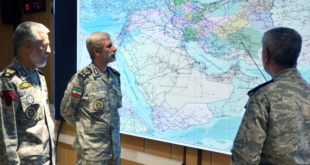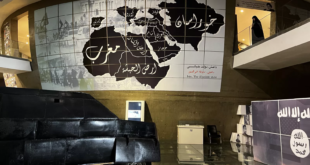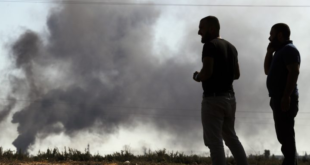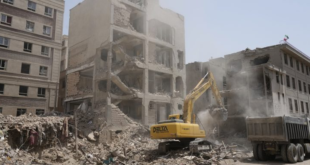U.S.-backed forces in northeastern Syria are warning the latest attempt by the Islamic State terror group to break thousands of its followers out of prison was part of a bigger plot designed to take and hold territory – a capability most Western counterterrorism officials have assessed to be beyond the group’s current reach.
Officials with the Syrian Democratic Forces said they based their conclusion on interrogations with captured Islamic State fighters and prisoners, and on documents recovered after the al-Sina’a prison in Hasaka and surrounding areas were secured.
“If their attack had succeeded, they would have attacked other neighborhoods in al-Hasaka as well, in conjunction with the attacks on the areas of al-Hol, al-Shadada, and Deir el-Zour, to put their extensive scheme into effect,” the SDF said in a statement Monday.
“They wanted to launch a large-scale attack on the area to spread once again their terrorism,” the SDF said, adding the IS-liberated areas were to be called the “Second Islamic State.”
While not downplaying the severity of the IS plot to free captured fighters from the prison in Hasaka, Western officials who spoke to VOA doubted the terror group is ready to try to re-establish a physical caliphate.
“I think that highly unlikely,” a Western counterterrorism official told VOA on the condition of anonymity to discuss sensitive intelligence.
“The local conditions do not currently exist for resurgence,” the official said, adding that the terror group is still trying to consolidate its networks across Syria and Iraq.
U.S. officials have previously described the IS operation to free up to 4,000 prisoners “a troubling event,” agreeing the size of the attacking force was significant.
But a U.S. official speaking to VOA prior to the latest SDF claims, characterized the IS assault on al-Sina’a more as an attempt to grow the group, which currently boasts anywhere from 8,000 to 16,000 fighters across Iraq and Syria, and to give it momentum.
“Something concrete like this can be really powerful,” the official said, asking to remain anonymous to discuss intelligence.
“They’ve made some incremental improvements, especially in rural areas,” the official said, warning any escaped prisoners could be absorbed into IS networks and boost the terror group’s operational capabilities.
But U.S. intelligence estimates do not envision IS trying to make a bigger, more permanent move for some time.
“In Iraq and Syria, ISIS remains committed to long-term goals,” the U.S. official said, using another acronym for the terror group. “They are working to shape the environment.”
IS launched the attack on the al-Sina’a prison nearly a week and a half ago, setting off at least one car bomb near the entrance to the complex before as many as 300 fighters converged on the facility.
The SDF initially announced it had retaken the facility, with help from U.S. and coalition forces, this past Wednesday. [[ https://www.voanews.com/a/us-backed-sdf-retakes-key-prison-in-battle-with-islamic-state/6413538.html ]] But fighting continued until Sunday, after SDF troops encountered a group of 60-90 IS prisoners barricaded in a building on the northern edge of the facility.
On Monday, the SDF said a total of 374 attackers and prisoners were killed in the effort to retake the prison and secure nearby neighborhoods.
Officials said 77 prison guards and other prison staff members had been killed along with 40 SDF soldiers and four civilians.
As of late Monday, the SDF said it was still trying to account for the whereabouts of more than 200 prisoners, but that most of the missing IS detainees are thought to be dead.
SDF commanders also rejected concerns that the IS attack managed to free many prisoners. Earlier estimates from U.S. officials put the number of escapees in the 10-20 range.
Coalition officials said Monday that the surviving prisoners had been transferred to a new, more secure facility.
Still questions remained about the fate 700 to 850 children – boys and teenagers – who had been housed in a separate facility in the al-Sina’a prison complex.
SDF officials said last week that IS fighters and prisoners had been using them as human shields during attempts to retake the complex but have given few updates.
At a news conference in Hasaka on Monday, a senior SDF commander, Mahmud Barkhadan, seemed to downplay the idea that children were caught up in the fighting, saying most of the boys at the facility, though taken into custody as children, were now 18 years of age or older.
Barkhadan also said there is evidence many of them took up arms during the attempted jailbreak, fighting alongside the other IS detainees.
The explanations, though, are not sitting well with human rights organizations.
“I am distressed,” Human Rights Watch Associate Director Letta Tayler told VOA Monday. “There’s a major information void at this point.”
HRW officials said last week it had spoken to an Australian boy who had at least initially escaped the fighting, and that he said two of his friends, a 14-year-old and a 15-year-old, had been killed.
HRW said it has also been told by the SDF that the prison complex had been home to boys as young as 12.
“Clearly, the SDF has its hands full right now … but as soon as possible, the world needs to know,” Tayler added.
For now, though, SDF officials said they are still trying to get a complete picture of the attack on al-Sina’a, alleging it appears to have been much more complex than they initially realized.
They said the attackers attempted to arm the prisoners by driving a “a large cargo car loaded with weapons and ammunition” to the prison gate.
They also said a network of tunnels “had been dug inside some houses in neighborhoods … in order to back the attack.”
Additionally, security operations both in areas around the prison, as well as in Deir el-Zour and in the city of Raqqa, resulted in another 40 arrests, the SDF claimed, noting 26 of the suspects were arrested for smuggling IS detainees in and out of the prison in Hasaka.
In its own propaganda, IS promoted the attack as proof that its self-declared caliphate has not been defeated.
“Have you seen a state … whose enemies declare its elimination once or twice a year?” the terror group asked in the latest version of its al-Naba online newsletter, published last week and translated by the SITE Intelligence Group.
“The soldiers of the Caliphate live,” the terror group added.
By contrast, U.S. and coalition officials have been quick to describe the attempted prison break as a major defeat for IS while also praising the SDF for its handling of the attack.
“Due to the effective response … senior ISIS leaders were captured or killed during the attempt,” State Department spokesperson Ned Price said in a statement Monday.
The U.S.-led coalition likewise praised the SDF response, tweeting that the IS jailbreak “failed by making detention facilities through the region more secure.”
Yet, underlying the congratulatory messages is a growing concern that IS is capable of using newfound strength to sow chaos in the region.
Iraqi officials said Sunday that the attack on the prison in Hasaka led them to take additional security precautions, specifically ordering the country’s elite Counterterrorism Service to inspect a number of facilities currently holding captured IS fighters.
“The barbarity of ISIS’s actions during this attack reaffirms why this group must be denied the ability to regenerate and why nations must work together to address the thousands of ISIS detainees in inadequate detention facilities,” U.S. National Security Adviser Jake Sullivan said in a statement late Sunday.
“ISIS remains a global threat that requires a global solution,” he added.
 Eurasia Press & News
Eurasia Press & News



